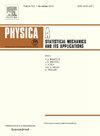Modeling and simulation of the fish collective behavior with risk perception and startle cascades
IF 2.8
3区 物理与天体物理
Q2 PHYSICS, MULTIDISCIPLINARY
Physica A: Statistical Mechanics and its Applications
Pub Date : 2025-02-01
DOI:10.1016/j.physa.2024.130337
引用次数: 0
Abstract
In this paper, an improved model of fish collective behavior is proposed, which combines social interactions with the risk perception and startle cascades behavior. By modeling the fast-start of fish individual and the startle propagation processes in fish school, the sudden collective evasion phenomenon during the fish collective behavior is studied. Utilizing this model, the paper focuses on investigating the impacts of cluster patterns and individual heterogeneity in social behavior and risk perception on the collective evasion process through simulations. The results show that the density of cluster aggregation is crucial in determining the propagation capability of startle responses. Conversely, the sudden startle propagation may completely change the type of cluster pattern for the cases in transitional zones. In some scenarios, a very small number of behaviorally heterogeneous individuals can dominate the cluster pattern of the entire group. Finally, it is found that distributing individuals with strong perception abilities around the periphery of the group while clustering those with weaker perception abilities within the inner group enhances the overall perception ability of the entire group.
求助全文
约1分钟内获得全文
求助全文
来源期刊
CiteScore
7.20
自引率
9.10%
发文量
852
审稿时长
6.6 months
期刊介绍:
Physica A: Statistical Mechanics and its Applications
Recognized by the European Physical Society
Physica A publishes research in the field of statistical mechanics and its applications.
Statistical mechanics sets out to explain the behaviour of macroscopic systems by studying the statistical properties of their microscopic constituents.
Applications of the techniques of statistical mechanics are widespread, and include: applications to physical systems such as solids, liquids and gases; applications to chemical and biological systems (colloids, interfaces, complex fluids, polymers and biopolymers, cell physics); and other interdisciplinary applications to for instance biological, economical and sociological systems.

 求助内容:
求助内容: 应助结果提醒方式:
应助结果提醒方式:


